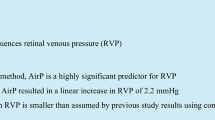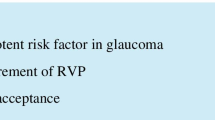Abstract
• Background: Does the venous collapse phenomenon provide the possibility of venous dynamometry? • Method: A technical model is presented which allows analysis of the conditions of the collapse of the central retinal vein in vitro. The conditions of the venous collapse were analysed with regard to intraocular pressure, intravasal pressure in the outflow of the central retinal vein and the overall perfusion. For clinical measurements dynamometry of the venous collapse is performed parallel to the experimental setting. • Results: The experiment reveals identical results for venous outflow pressure measured by venous dynamometry and by intravasal pressure detector. Venous dynamometry in vivo means that we use the onset of the venous collapse phenomenon to register the pressure in the central retinal vein at the point where it leaves the eye. Using this technique, retroocular obstruction of the venous outflow may be assessed. The venous outflow pressure itself depends on the venous flow resistance, intracranial pressure and arterial perfusion pressure. Any disorder of these three parameters may be assessed when the absolute venous outflow pressure is registered. • Conclusion: The venous collapse phenomenon enables us to determine the venous outflow pressure. Clinical applications have proven promising.
Similar content being viewed by others
References
Baurmann M (1925) Über die Entstehung und klinische Bedeutung des Netzhautvenenpulses. Dtsch Ophthalmol Ges 45:53–59
Campo RV, Reiss GR (1992) Glaucoma associated with retinal disorders and retinal surgery. In: Tasman W, Jaeger EA (eds), Duanes clinical ophthalmology 3. Lippincott, Philadelphia
Duke-Elder S, Jay B (1969) Glaucoma and hypotony. In: Duke-Elder S (ed) Diseases of the lens and vitreous. (System of Ophthalmology, vol 11) Kimpton, London, pp 678–681
Kukán F (1937) Mit einem selbst konstruierten Apparat ausgeführte Untersuchungen über den Zusammenhang zwischen dem Blutdruck der Retinagefäβe und dem Hirndruck (Sitzungsbericht). Klin Monatsbl Augenheilkd 98:680
Lang J (1979) Kopf. B. Gehirn- und Augenschädel. Springer, Berlin Heidelberg New York, pp 645–647
Lavergne G (1988) L'Hypertonie oculaire de l'ophtalmopathie endocrinienne. Bull Soc Beige Ophtalmol 226:37–45
Moses RA, Grodzki WJ Jr (1985) Mechanism of glaucoma secondary to increased venous pressure. Arch Ophthalmol 103:1701–1703
Niesel P, Steiner W (1962) Modellexperimente zur Bedeutung des spontanen Venenpulses. Klin Monatsbi Augenheilkd 155:681–687
Sandston AC (1963) Glaucoma following thyrotropic exophthalmos. Trans Ophthalmol Soc N Z 16:61–66
Schulte D (1948) Gefäβstudien mit Augenspiegel und Spaltlampe. 1. Mitteilung: Beobachtungen über den Netzhautvenenpuls. Klin Monatsbi Augenheilkd 113:220–230
Ulrich W-D, Ulrich C (1985) Okuloozillodynamographie, ein neues Verfahren zur Bestimmung des Ophthalmikablutdruckes und zur okulären Pulskurvenanalyse. Klin Monatsbl Augenheilkd 186:385–388
Ulrich W-D, Ulrich C, Neunhöffer E, Fuhrmann P (1987) Okulopressions-Tonometrie (OPT) — ein neues tonographisches Verfahren zur Glaukomdiagnostik. Klin Monatsbl Augenheilkd 190:109–113
Zappia R, Winkelmann J, Gay AJ (1971) Intraocular pressure changes in normal subjects and the adhesive muscle syndrome. Am J Ophthalmol 71:880–883
Author information
Authors and Affiliations
Rights and permissions
About this article
Cite this article
Meyer-Schwickerath, R., Kleinwächter, T., Papenfuß, H.D. et al. Central retinal venous outflow pressure. Graefe's Arch Clin Exp Ophthalmol 233, 783–788 (1995). https://doi.org/10.1007/BF00184090
Received:
Revised:
Accepted:
Issue Date:
DOI: https://doi.org/10.1007/BF00184090




